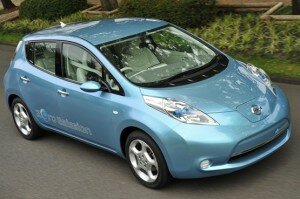Nissan has just unveiled the prototype of its first electric car, the Leaf, available in Australia from 2012, and in Japan and the USA from next year. It will have a range of 160kms, a top speed of 140km/hr and a 5 to 30 minute rapid charge. The car is a 5 door hatch. Incredibly the battery pack will only weigh 200kg.

Nissan Leaf electric vehicle
By going for a rapid-charge battery the Leaf is competing with the Better Place model of physically changing the battery once depleted for a fully charged battery. Presumably you could drive into a service station with rapid charge capability and be fully charged in 5 to 10 minutes, not an unacceptable delay if you don’t have to do it that frequently.
The relatively long range (160kms) of the Leaf reduces the need for a network of charge points at car parks, also key to the Better Place model. The Leaf is suited to home charging, with a 8 hour “trickle” charge.
Pricing has not yet been announced. Nissan are planning to sell the car but lease the battery to the first customers, with the price of the car (excluding battery) to be similar to that of a small family car. The cost of the battery lease and electricity to charge the battery will be less than that of petrol for an equivalent vehicle.
An advantage of the Better Place model though is its integration with the “smart grid”, whereby whenever the vehicle is parked a charge station is nearby it can be interacting with the grid and providing storage to renewable generation.
Other electric cars which may be available in Australia in 2012 include:
- The Mitsubishi i-MiEV (perhaps available from 2010). A small car, also with a 160km range.
- The Holden Volt. Another small vehicle.
- Vehicles compatible with the Better Place model (in Canberra, where Better Place is starting its national rollout)
- The Toyota FT-EV
Already available is the Blade, a modified Hyundai Getz.
Metropolitan fleet buyers – local government and commercial would be doing well to now start planning to introduce electric vehicles into their fleets from 2012. Which, if Nissan and Better Place deliver on their schedules and prices, won’t only make environmental sense, but will also make financial sense if the capital cost is no more, and running costs are lower.




